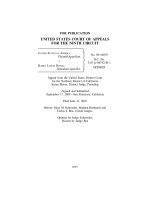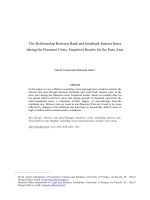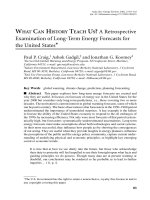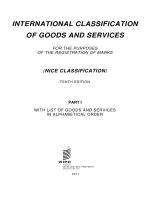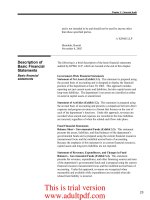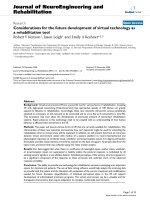Clearing Services for Global Markets A Framework for the Future Development of the Clearing Industry_1 pptx
Bạn đang xem bản rút gọn của tài liệu. Xem và tải ngay bản đầy đủ của tài liệu tại đây (1.48 MB, 38 trang )
This page intentionally left blank
Clearing Services for Global Markets
Clearing forms the core part of a smooth and efficiently functioning financial market
infrastructure. Traditionally, it has been provided by clearing houses, most of which
today act as a ‘central counterparty’ (CCP) between the two sides of a trade. The rapid
growth of cross-border trading has sparked discussion on the most efficient industry
structure – particularly in Europe and the USA. At the heart of this discussion
lies the question of whether the implementation of a single clearing house creates
greater benefits than a more competitive but interlinked market structure. This is the
starting point for this book, which analyses the efficiency of clearing and clearing
industry structure. Along with clear-cut definitions and a concise characterisation
and descriptive analysis of the clearing industry, the book determines the efficiency
impact of various cross-border integration and harmonisation initiatives between
CCPs. This serves to identify the most preferable future structure for the clearing
industry.
Tina P. Hasenpusch works for Barclays Capital in London. Prior to her career at Barcap,
she completed her PhD in Banking and Finance at the European Business School in
Germany with a summa cum laude. Tina also worked in the Trading and Clearing
Market Development depar tment of Eurex, the world’s leading derivatives exchange
and clearing house. Her research focus and expertise are in the fields of securities and
derivatives trading, clearing and settlement systems.
Advance praise for Clearing Services for Global Markets
‘The book features three real-world case studies br inging clearing to life. It is a
thorough and insightful exposition of clearing and a must-read for anyone interested
in the subjec t matter.’
PAUL J. BRODY
Chief Financial Officer of Interactive Brokers Group and Timber Hill LLC, and Board
Member of the Options Clearing Corporation
‘Only few academic contributions have been published on clearing and no compre-
hensive and readable standard literature exists. I can definitely see this book filling
the void in becoming a standard work on clearing.’
ORLANDO CHIESA
Senior clearing house expert
‘This book’s unique character and contribution result from an unprecedented number
of interviews and feedback sessions with academics and industry experts. The list of
these people truly reads like the “Who’s Who” of the der ivatives world. This book is
essential for anyone with an interest in clearing issues.’
DENNIS DUT TERER
Independent clearing consultant and former President and Chief Executive Officer of
the Clearing Corporation
‘I don’t know of anyone who hasthought as deeply and written asthoroughly about the
key issues related to clearing as Tina Hasenpusch. Anyone interested in the mysterious
but critically important process of clearing, especially in the issues that arise as markets
and clearing become more global, should read this book.’
MICHAEL GORHAM
Industry Professor and Director of the IIT Stuart Center for Financial Markets and
co-author of Electronic Exchanges: The Global Transformation from Pits to Bits
‘This is a great piece of work! It becomes the textbook for anybody interested in the
process of clearing trades. It is extremely well researched and written.’
CHRISTOPHER K. HEHMEYER
President and Chief Executive Officer of PensonGHCO, founding partner of Golden-
berg, Hehmeyer & Co., former Chairman of the Board of Trade Clearing Corporation
and Director of the Chicago Board of Trade
‘If anyone ever had doubts about how exciting clearing could be – this book will change
your thinking. You will find that, despite its scope, it turns out to be a surprisingly
fun read.’
DAVID KRELL
Co-founder of the International Securities Exchange
‘Tina Hasenpusch has taken a view of the complex world of securities and derivatives
clearing and provided her readers with an analysis of uncommon transparency. The
analysis is based on diligent fact-gathering structured with a logical vision of the
broadly defined market. Her message is delivered with both clarity and grace.’
JAMES J. MCNULTY
Director of NYSE Euronext, Director of ICAP Plc and former President and Chief
Executive Officer of the Chicago Mercantile Exchange
‘Ms Hasenpusch’s book dares to go where others have not and provides an innovative
insight into the economics of clearing, using real-world examples. Executives of
exchanges, clearing organizations and banks should be interested in this scholarly
work, as should relevant national authorities and central banks.’
JOHN MCPARTLAND
Financial Markets Advisor to the Federal Reserve Bank of Chicago, and international
clearing and settlement consultant
‘This book is a joy to read. Ms Hasenpusch has a gift for explaining difficult concepts.
She makes it remarkably easy to deep dive into the world of clearing.’
OTTO E. N
¨
AGELI
Managing Partner of OEN Consulting, former Deputy Chief Executive Officer of
Eurex, and Member of the Executive Board of SWX Swiss Exchange
‘This book is very timely and well worth reading, given the many changes afoot in the
areas of exchange regulation and clearing.’
HARVEYL.PITT
Chief Executive Officer of Kalorama Partners and former Chairman of the Securities
and Exchange Commission
‘Particularly in the light of recent market dislocations, clearing is critical for the
assurance of a healthy functioning of the financial markets. This book will have an
enormous audience.’
MARK SPANBROEK
Partner of a privately held electronic trading firm
Clearing Services for
Global Markets
A Framework for the Future Development
of the Clearing Industr y
Tina P. Hasenpusch
CAMBRIDGE UNIVERSITY PRESS
Cambridge, New York, Melbourne, Madrid, Cape Town, Singapore,
São Paulo, Delhi, Dubai, Tokyo
Cambridge University Press
The Edinburgh Building, Cambridge CB2 8RU, UK
First published in print format
ISBN-13 978-0-521-51871-0
ISBN-13 978-0-511-63510-6
© Tina P. Hasenpusch 2009
The views expressed by research participants in interviews are their own and do
not necessarily represent the official stance of their organisation. The interviewees
are not associated with the final conclusions of this study. The findings of this
study thus do not necessarily reflect the views of the individuals interviewed in the
context of this study. Any proposition that is forwarded is arrived at through a
rigorous, independent academic methodology. The findings of the book do not
necessarily represent the official stance of Barclays Capital. The International
Capital Market Association’s sponsorship of this publication aims to promote
research and the continuing development of the market. ICMA did not exercise
any editorial control over this publication and as such the findings do not
necessarily reflect the official stance of the Association.
2009
Information on this title: www.cambrid
g
e.or
g
/9780521518710
This publication is in copyright. Subject to statutory exception and to the
provision of relevant collective licensing agreements, no reproduction of any part
may take place without the written permission of Cambridge University Press.
Cambridge University Press has no responsibility for the persistence or accuracy
of urls for external or third-party internet websites referred to in this publication,
and does not guarantee that any content on such websites is, or will remain,
accurate or appropriate.
Published in the United States of America by Cambridge University Press, New York
www.cambridge.org
eBook
(
NetLibrar
y)
Hardback
This book is for my beloved parents, Heike Maria and Bruno Hasenpusch
With love and gratitude
Table of contents
List of figures page xvii
List of abbreviations xxiii
Acknowledgements xxviii
Foreword xxxi
1 Introduction 1
1.1 Problem definition 2
1.2 Literature and research gap 6
1.3 Purpose of study 9
1.4 Focus area of research 11
1.5 Structure of study 13
2 Setting the stage – definitions and industry setting 16
2.1 Definition of clearing 17
2.1.1 Process view 18
2.1.2 Functional view 19
2.1.2.1 Basic clearing services 20
2.1.2.1.1 Trade confirmation 20
2.1.2.1.2 Transaction/position management 21
2.1.2.1.3 Delivery management 22
2.1.2.2 Value-added clearing services 22
2.1.2.2.1 Unique CCP services 23
2.1.2.2.1.1 Novation 23
2.1.2.2.1.2 Netting 24
2.1.2.2.1.3 Risk management 28
2.1.2.2.2 Collateral management 31
2.1.2.2.3 Cash management 32
2.1.2.3 Complementary clearing services 32
2.1.3 Structural view 33
2.1.3.1 Alternative execution venues/exchanges as clearing service providers 35
x Table of contents
2.1.3.2 CSDs and ICSDs as clearing service providers 36
2.1.3.3 CCPs as clearing service providers 37
2.1.3.4 Banks/brokers as clearing service providers 38
2.1.4 Institutional view 39
2.2 Value-added of CCP clearing 41
2.2.1 Microeconomic view 41
2.2.2 Macroeconomic view 44
2.2.2.1 Allocation of risk 45
2.2.2.2 Allocation of capital 46
2.2.2.3 Market liquidity 46
2.2.3 Asset class view 47
2.3 The Value Provision Network 50
2.3.1 Structure of the Value Provision Network 50
2.3.2 Clearing member types 52
2.4 Stakeholders in clearing 57
2.5 Current clearing industry str uctures 60
2.5.1 Europe 62
2.5.2 United States 66
2.5.3 Comparing Europe and the United States 68
2.6 Summary 70
3 Defining the core issues – efficiency and network strategies 73
3.1 Efficiency of derivatives clearing 73
3.1.1 General efficiency criteria 74
3.1.2 Operational efficiency and transaction cost theory 76
3.2 Transaction costs of derivatives clearing 79
3.2.1 Direct transaction costs 82
3.2.1.1 Clearing house charges 84
3.2.1.2 Service provider charges 86
3.2.2 Indirect transaction costs 88
3.2.2.1 Cost of capital 88
3.2.2.2 Risk management costs 93
3.2.2.3 Information technology costs 95
3.2.2.4 Back-office costs 96
3.3 Network strategies 99
3.3.1 Classification of network strategies 100
3.3.1.1 Cross-margining agreements 101
3.3.1.2 Clearing links 103
3.3.1.3 Mergers and acquisitions 110
xi Table of contents
3.3.1.4 Single central counterparty 111
3.3.2 Over view of network initiatives from 1973 to 2006 113
3.4 Summary 117
4 Collecting empirical insights – introduction to the empirical study 119
4.1 Underlying data 119
4.2 Method and process of data collection 124
4.3 Structure of empirical study 126
4.4 Data treatment and interpretation 128
4.5 Quality of expert inquiry 130
4.6 Summary on purpose and use of the empirical insights 131
5 Analysing costs of derivatives clearing – transaction cost studies 133
5.1 Findings from empirical study 134
5.1.1 Relevance of clearing costs to clearing members 135
5.1.1.1 Cost awareness 136
5.1.1.2 Monitoring of all-in costs 139
5.1.1.3 Employment of a cost management system 140
5.1.1.4 Ability to assess relevance of cost categories 140
5.1.2 Direct versus indirect clearing costs 141
5.1.2.1 Clearing members’ view 142
5.1.2.2 Other interv iewee groups’ views 145
5.1.2.3 Conclusions from Figure 5.4 145
5.1.3 Clearing members’ core cost drivers 145
5.1.4 Cost categories revised 150
5.1.4.1 Direct costs 150
5.1.4.2 Cost of capital 151
5.1.4.3 Risk management costs 153
5.1.4.4 Information technology costs 154
5.1.4.5 Back-office costs 156
5.2 Transaction cost analyses 156
5.2.1 Clearing house fees 157
5.2.2 Clearing houses’ volume discount schemes 164
5.2.3 Total European clearing industry costs in 2005 167
5.2.4 Clearing members’ average direct and indirect costs 173
5.2.5 Clearing members’ unit costs 175
5.2.6 Derivatives clearing versus other market infrastructure costs 177
5.2.7 Cost reduction scenarios for clearing members 180
5.2.8 Non-clearing members’ perspectives 185
xii Table of contents
5.2.9 Cost reduction scenarios for non-clearing members 186
5.3 Summary of findings 190
5.3.1 Findings from empirical study 190
5.3.2 Transaction cost analyses – clearing members 191
5.3.3 Transaction cost analyses – non-clearing members 193
6 Exploring theoretical basics – scale effects in clearing 195
6.1 Demand-side scale effects 195
6.1.1 Network effects 197
6.1.1.1 First level (CCP level) network effects 202
6.1.1.1.1 First level network effects: product layer 202
6.1.1.1.2 First level network effects: system layer 207
6.1.1.2 Second level (GCM level) network effects 210
6.1.1.2.1 Second level network effects: product l ayer 210
6.1.1.2.2 Second level network effects: system layer 211
6.1.1.3 Interrelation between CCP and GCM level network effects 212
6.1.1.4 Spill-over effects of CCP and GCM level network effects 214
6.1.2 Network economic particularities 216
6.1.2.1 Compatibility 216
6.1.2.2 Installed base 218
6.1.2.3 Start ing problem 218
6.1.2.4 Innovative ability and lock-in 219
6.2 Supply-side scale effects 220
6.2.1 Economies of scale 223
6.2.2 Economies of scope 226
6.2.3 Clearing houses’ cost structures 228
6.2.4 Cost implications of scale and scope enlargements 231
6.2.5 Preliminary conclusions 234
6.3 Summary of findings 235
6.3.1 Demand-side scale effects 235
6.3.2 Supply-side scale effects 237
7 What theory reveals – framework for efficiency analysis of
network strategies 239
7.1 Scale Impact Matrix 242
7.1.1 Analysis of network strategies’ supply-side scale effects 243
7.1.2 Analysis of network strategies’ demand-side scale effects 246
7.1.2.1 Impact on CCP and GCM level network sizes 246
7.1.2.2 Network economic particularities 247
xiii Table of contents
7.1.2.2.1 Installed base 248
7.1.2.2.2 Start ing problem 249
7.1.2.2.3 Lock-in 251
7.1.2.2.4 Growth potential 253
7.1.2.3 Potential for network effects 254
7.1.2.4 Potential to internalise GCM level network effects 256
7.1.2.5 Net positive network effects 257
7.2 Transaction Cost Impact Matrix and Efficiency Impact Matrix 258
7.2.1 Transaction Cost Impact Matrix (TCIM) 258
7.2.1.1 TCIM for regionally active clearing members 261
7.2.1.2 TCIM for regionally-to-globally active clearing members 263
7.2.1.3 TCIM for globally active clearing members 265
7.2.2 Efficiency Impact Matrix 267
7.3 Business Model Impact Matrix (BMIM) 268
7.3.1 BMIM for regionally active clearing members 269
7.3.2 BMIM for regionally-to-globally active clearing members 270
7.3.3 BMIM for globally active clearing members 272
7.4 Preliminary findings – impact of network st rategies on efficiency 275
7.4.1 Scale Impact Matrix 276
7.4.2 Transaction Cost Impact Matrix 276
7.4.3 Efficiency Impact Matrix 277
7.4.4 Business Model Impact Matrix 278
7.4.5 Summary of impact 279
8 Checking theory against reality – case studies of network strategies 285
8.1 The clearing link study 286
8.1.1 Findings from the empirical study 287
8.1.1.1 Cross-margining agreements: general benefits and constraints 287
8.1.1.2 Clearing links: general benefits and constraints 291
8.1.1.3 Suitability of clearing links to integrate European clearing 296
8.1.2 Case study: Eurex Clearing and The Clearing Corporation 300
Part I: Introduction 301
8.1.2.1 Profiles of the partnering clearing houses 301
8.1.2.1.1 Eurex Clearing 301
8.1.2.1.2 The Clearing Corporation 303
8.1.2.2 Background and objectives of the initiative 306
8.1.2.3 Concept and structure of the initiative 310
8.1.2.4 Status of the initiative 312
Part II: Analysis 313
xiv Table of contents
8.1.2.5 Interviewees’ assessment of the case study 313
8.1.2.6 Scale Impact Matrix 315
8.1.2.6.1 Analysis of supply-side scale effects 316
8.1.2.6.2 Analysis of demand-side scale effects 319
8.1.2.6.2.1 Impact on network sizes 320
8.1.2.6.2.2 Network economic particularities 323
8.1.2.6.2.3 Network effects 325
8.1.2.6.2.4 Internalisation of GCM level network effects 327
8.1.2.6.2.5 Net positive network effects 328
8.1.2.6.3 Over view Scale Impact Matrix 328
8.1.2.7 Transaction Cost Impact Matrix and Efficiency Impact Matrix 330
8.1.2.7.1 TCIM for regionally active clearing members 331
8.1.2.7.2 TCIM for regionally-to-globally active clearing members 332
8.1.2.7.3 TCIM for globally active clearing members 334
8.1.2.7.4 Efficiency Impact Matrix 336
8.1.2.8 Business Model Impact Matrix 337
8.1.2.8.1 BMIM for regionally active clearing members 337
8.1.2.8.2 BMIM for regionally-to-globally active clearing members 338
8.1.2.8.3 BMIM for globally active clearing members 340
8.1.3 Summary of findings – impact of clearing links on efficiency 342
8.1.3.1 Scale Impact Matrix 343
8.1.3.2 Transaction Cost Impact Matrix 344
8.1.3.3 Efficiency Impact Matrix 344
8.1.3.4 Business Model Impact Matrix 344
8.2 The merger study 345
8.2.1 Case study: the London Clearing House and Clearnet 346
Part I: Introduction 347
8.2.1.1 Profile of the partnering clearing houses 347
8.2.1.1.1 The London Clearing House 347
8.2.1.1.2 Clearnet 349
8.2.1.2 Background and objectives of the initiative 351
8.2.1.3 Concept and structure of the initiative 354
8.2.1.4 Status of the initiative 359
Part II: Analysis 362
8.2.1.5 Interviewees’ assessment of the case study 362
8.2.2 Summary of findings – impact of mergers and acquisitions
on efficiency 370
8.2.2.1 Scale Impact Matrix – supply-side scale effects 370
8.2.2.2 Scale Impact Matrix – demand-side scale effects 371
xv Table of contents
8.2.2.3 Transaction Cost Impact Matrix 372
8.2.2.4 Efficiency Impact Matrix 373
8.2.2.5 Business Model Impact Matrix 373
8.3 The single central counterpart y study 375
Part I: Introduction 375
8.3.1 Background and objectives of the initiative 375
Part II: Analysis 377
8.3.2 Findings from the empirical study 377
8.3.2.1 Single European CCP: potential benefits and constraints 378
8.3.2.2 Suitability of a sing le CCP to integ rate European clearing 383
8.3.3 Summary of findings – impact of a single CCP on efficiency 386
8.3.3.1 Scale Impact Matrix – supply-side scale effects 386
8.3.3.2 Scale Impact Matrix – demand-side scale effects 387
8.3.3.3 Transaction Cost Impact Matrix 387
8.3.3.4 Efficiency Impact Matrix 388
8.3.3.5 Business Model Impact Matrix 388
8.4 Final assessment – impact of network strategies on efficiency 389
8.4.1 Clearing links 389
8.4.2 Mergers and acquisitions 390
8.4.3 Single CCP 391
9 Quantifying the efficiency impact – European network strategies 393
9.1 Total European industry costs 393
9.1.1 Efficiency impact of clearing links 394
9.1.2 Efficiency impact of a single CCP 395
9.2 European clearing members’ average costs 398
9.2.1 Efficiency impact of clearing links 399
9.2.2 Efficiency impact of a single CCP 401
9.3 Summary 403
9.3.1 Total European industry costs 403
9.3.2 European clearing members’ average costs 404
10 Introducing the future network economy – development of the
clearing industry 406
10.1 Future development of the European clearing industry 406
10.1.1 Recommendation for European derivatives clear ing 407
10.1.2 Application of findings to cash equities clearing 413
10.1.3 Competitive dynamics in the European clearing industry 414
10.1.4 Reconcilability of findings with the Code of Conduct 416
xvi Table of contents
10.1.5 Who should link to whom 417
10.1.5.1 Zero concentration 419
10.1.5.2 Zone concentration 419
10.1.5.3 Lane concentration 419
10.1.6 Structural changes in the Value Provision Network 420
10.2 European clear ing in a global context 423
10.3 Summary 424
10.3.1 Future development of the European clearing industry 424
10.3.2 European clearing in a global context 427
11 Summary, discussion and recommendations for future research 428
11.1 Summary of research results 428
11.1.1 Chapter 2 – Setting the stage – definitions and industry setting 428
11.1.2 Chapter 3 – Defining the core issues – efficiency and network strategies 429
11.1.3 Chapter 4 – Collecting empirical insights – introduction to the
empirical study 430
11.1.4 Chapter 5 – Analysing costs of derivatives clearing – transaction
cost studies 430
11.1.5 Chapter 6 – Exploring theoretical basics – scale effects in clearing 431
11.1.6 Chapter 7 – What theory reveals – framework for efficiency analysis of
network stategies 432
11.1.7 Chapter 8 – Checking theory against reality – case studies of network
strategies 433
11.1.8 Chapter 9 – Quantifying the efficiency impact – European network
strategies 434
11.1.9 Chapter 10 – Introducing the future network economy – development
of the clearing industry 435
11.2 Discussion and recommendations for future research 436
Appendices 441
Bibliography 500
Index 527
List of figures
1.1 Layout of the study page 14
2.1 Structure of Chapter 2 17
2.2 Process view on clearing 19
2.3 Functional view on clearing 20
2.4 Legal relationship between counterparties to a trade prior to and after
novation 24
2.5 The exchange of payments arising from financial transactions 25
2.6 Structural view on clearing – clearing service providers according to
process 34
2.7 Structural view on clearing – clearing service providers according to
function 35
2.8 Institutional view on clearing 40
2.9 Microeconomic benefits of CCP clearing 43
2.10 Asset class view on the value-added of CCP clearing 48
2.11 The Value Provision Network of clearing 51
2.12 Typical clearing member types classified by their business focus 53
2.13 Classification of regionally active clearers (CM
PR
/CM
AR
) 54
2.14 Classification of regionally-to-globally active clearers
(CM
PR-G
/CM
AR-G
) 55
2.15 Classification of globally active clearers (CM
PG
/CM
AG
) 56
2.16 Typical clearing member types classified by cleared market share 57
2.17 Overview of principal financial market infrastructures in selected
European countries 63
2.18 European clearing industr y – market share distribution of
exchange-traded derivatives volumes from 1998 to 2005 64
2.19 European derivatives clearing industry – average annual market share
distribution of different clearing member types 65
2.20 Overview of principal financial market infrastructure in the US 68
xviii List of figures
2.21 Development of exchange-traded derivatives volumes (single
counted) at the largest US-American and European CCPs from 1998
to 2005 69
3.1 Structure of Chapter 3 74
3.2 Categorisation of clearing-related transaction costs 79
3.3 Cost types and categories 81
3.4 Transaction costs in the Value Provision Network 81
3.5 Categorisation of direct transaction costs 83
3.6 Categorisation of clearing-related cost of capital 89
3.7 Categorisation of clearing-related risk management costs 93
3.8 Categorisation of clearing-related information technology costs 95
3.9 Categorisation of clearing-related back-office costs 97
3.10 Classification of network strategies between clearing houses 100
3.11 Classification of cross-margining agreements according to their
functional set-up 102
3.12 Clearing links’ impact on the structure of the Value Provision
Network 104
3.13 Classification of clearing links according to their business purpose 105
3.14 Classification of clearing links according to their functional set-up 107
3.15 Impact of mergers and acquisitions on the structure of the Value
Provision Network 111
3.16 Single CCP’s impact on the structure of the Value Provision Network 112
3.17 Selection of cross-margining agreements and clearing links
(status: I = Implemented; F = Failed) 114
3.18 Selection of mergers and acquisition and single CCP initiatives
(status: I = Implemented; F = Failed; O = Open) 116
4.1 Structure of Chapter 4 120
4.2 Empirical study – positive response rate of contacted individuals
according to interv iewee groups 121
4.3 Empirical study – number of interviewees by group and location 123
4.4 Empirical study – insight pursued by interviews and questionnaire 132
5.1 Structure of Chapter 5 134
5.2 Clearing members’ perception of transaction costs of derivatives
clearing 135
5.3 Factors influencing the level of cost awareness 136
5.4 Interviewees’ assessment of clearing members’ strongest transaction
cost drivers 142
5.5 Composition of all-in clearing costs for six interviewed benchmark
clearing members 146
xix List of figures
5.6 Clearing members’ focus area in terms of cost reductions 148
5.7 Key factors influencing perception of cost types 150
5.8 Clearing and trading fees for €500,000 hedge in equity options or
equity futures 159
5.9 Clearing and trading fees for €500,000 hedge in index options or
index futures 161
5.10 Clearing and trading fees for €500,000 hedge in interest rate futures 162
5.11 Clearing houses’ volume discounts in benchmark products, as of
September 2006 165
5.12 Clearing houses’ volume discounts and benefiting clearing member
types 166
5.13 Total European derivatives clearing costs in 2005 168
5.14 Composition of total European derivatives clearing costs in 2005 171
5.15 Per cent stake of different clearing member types in European
derivatives clearing costs in 2005 172
5.16 Average annual direct and indirect costs for clearing member
archetypes 174
5.17 Classification of cost reduction opportunities for clearing members 181
6.1 Structure of Chapter 6 196
6.2 Telephone network as a simple star network 199
6.3 Value Provision Network as a two-layered and two-level network 201
6.4 First level (CCP level) network effects on the product and
system layers 203
6.5 Number of cleared derivatives products and clearing members in
2005 (N=6) 204
6.6 Development of open interest and number of participants at Eurex
from 1997 to 2001 206
6.7 Second level (GCM level) network effects on the product and system
layers 210
6.8 Unit costs and number of cleared contracts of selected clearing houses
from 1999 to 2005 (N=9) 225
6.9 Potential for economies of scale and scope – LCH.Clearnet 229
6.10 Cost structure of selected clearing houses in 2005 230
7.1 Structure of Chapter 7 240
7.2 Framework for efficiency analysis of network strategies 240
7.3 Scale Impact Matrix 242
7.4 Typified assessment of the potential for e conomies of scale and scope
in different network strategies 243
7.5 Deriving the network strategies’ net supply-side scale effects 244
xx List of figures
7.6 Typified assessment of network strategies’ potential for positive and
negative CCP level network effects 254
7.7 Deriving the network st rategies’ net demand-side scale effect 257
7.8 Systemised impact of demand- and supply-side scale effects on
transaction costs 259
7.9 Transaction Cost Impact Matrix for regionally active clearing
members 261
7.10 Transaction Cost Impact Matrix for regionally-to-globally active
clearing members 264
7.11 Transaction Cost Impact Matrix for globally active clearing members 265
7.12 Efficiency Impact Matrix 268
7.13 Business Model Impact Matrix for regionally active clearing members 269
7.14 Business Model Impact Matrix for regionally-to-g lobally active
clearing members 271
7.15 Business Model Impact Matrix for globally active clearing members 273
7.16 Business Model Impact Matrix for globally active clearers that succeed
in implementing restricted access to the CCP level network 275
7.17 McP curve – public versus private benefits in the context of CCP
consolidation 282
8.1 Structure of Chapter 8 286
8.2 Interviewees’ assessment of cross-margining agreements 288
8.3 Interviewees’ assessment of clearing links 292
8.4 Interviewees’ assessment of the suitability of clearing links to integrate
the European clearing industry 297
8.5 Organisational and corporate structure Eurex Clearing AG 302
8.6 Three-phased implementation approach of the Global Clearing Link 311
8.7 The Global Clearing Link concept (Phases I to III implemented) 312
8.8 Interviewees’ assessment of the Global Clearing Link 314
8.9 Assessment of economies of scale and scope in the Global
Clearing Link 316
8.10 Deriving the Global Clearing Link’s net supply-side scale effects 319
8.11 Typified assessment of the Global Clearing Link’s positive and
negative network effects 326
8.12 The Global Clearing Link’s net demand-side scale effects 328
8.13 The Global Clearing Link’s Scale Impact Matrix 329
8.14 Transaction Cost Impact Matrix for regionally active
clearing members 331
8.15 Transaction Cost Impact Matrix for regionally-to-globally active
clearing members 332
xxi List of figures
8.16 Transaction Cost Impact Matrix for globally active clearing members 334
8.17 The Global Clearing Link’s Efficiency Impact Matrix 336
8.18 Business Model Impact Matrix for regionally active clearing members 338
8.19 Business Model Impact Matrix for regionally-to-g lobally active
clearing members 339
8.20 Business Model Impact Matrix for globally active clearing members 341
8.21 Pre-merger ownership structure London Clearing House 348
8.22 Pre-merger ownership structure Clearnet 350
8.23 Post-merger ownership structure LCH.Clearnet Group, as of
January 2004 356
8.24 Integration phasing of the LCH/Clearnet merger 358
8.25 Interviewees’ assessment of whether or not the merger of LCH and
Clearnet had made sense in 2003 363
8.26 Interviewees’ assessment of whether or not the merger of LCH and
Clearnet has so far provided value-added ( answers provided in
May 2006) 365
8.27 Interviewees’ assessment of whether or not the expected value-added
of the LCH and Clearnet merger will be realised in the future (answers
provided in May 2006) 368
8.28 Interviewees’ assessment of whether or not they support the creation
of a single European CCP to integrate the European clearing industry 384
8.29 Assessment of how many interviewees who were for or conflicted
about the creation of a single European CCP believed that the
potential benefits of the initiative can/cannot be achieved differently 385
9.1 Structure of Chapter 9 394
9.2 Total European derivatives clearing costs in 2005 – efficiency impact
of clearing links 395
9.3 Per cent stake of different clearing member types in European
derivatives clearing costs in 2005 – under the assumption of
implemented European clearing links 396
9.4 Total European derivatives clearing costs in 2005 – efficiency impact
of a single European CCP 397
9.5 Per cent stake of different clearing member types in European
derivatives clearing costs in 2005 – under the assumption of an
implemented single European CCP 398
9.6 Average annual direct and indirect costs for clearing member
archetypes – under the assumption of implemented European
clearing links 399
xxii List of figures
9.7 Average unit costs for clearing member archetypes – under the
assumption of implemented European clearing links 400
9.8 Average annual direct and indirect costs for clearing member
archetypes – under the assumption of an implemented single
European CCP 401
9.9 Average unit costs for clearing member archetypes – under the
assumption of an implemented single European CCP 402
9.10 Total European derivatives clearing costs in 2005 – overview of
estimated potential savings under the assumption of implemented
European clearing links or an implemented single European CCP 404
10.1 Structure of Chapter 10 407
List of abbreviations
a/c/e alliance/CBOT/Eurex
ADECH Athens Derivatives Exchange Clearing House
AEV alternative execution venue
AEX Amsterdam Exchange
AFEI Association Franc¸aise des Entreprises d’Investissement
AFTI Association Franc¸aise des Professionnels des Titres
AG Aktiengesellschaft
AMEX American Stock Exchange
API Application Programming Interface
Arca Archipelago
ATS Alternative Trading Systems
BIS Bank for International Settlements
BMIM Business Model Impact Matrix
BoNY Bank of New York
BOTCC Board of Trade Clearing Corporation
BOX Boston Options Exchange
BSE Boston Stock Exchange
BV Besloten Vennootschap (Dutch limited company)
BVLP Bolsa de Valores de Lisboa e Porto
BXS Brussels Stock Exchange
CBOE Chicago Board Options Exchange
CBOT Chicago Board of Trade
CC&G Cassa di Compensazione e Garanzia
CCorp Clearing Corporation
CCOS Clearing Cor poration for Options and Securities
CCP central counterparty
CCP.A CCP Austria
CEO Chief Executive Officer
CEPS Centre for European Policy Studies
CESAME Group Clearing and Settlement Advisory and Monitoring Expert Group
CESR Committee of European Securities Regulators
Cf. confer
CFE CBOE Futures Exchange
CFO Chief Financial Officer
CFS Centre for Financial Studies

